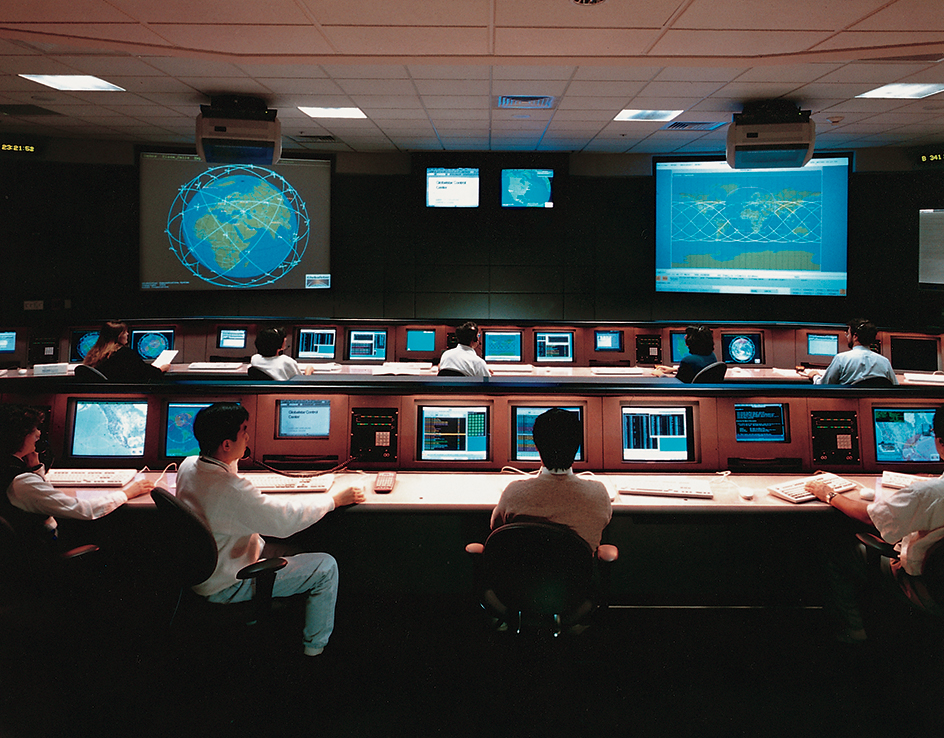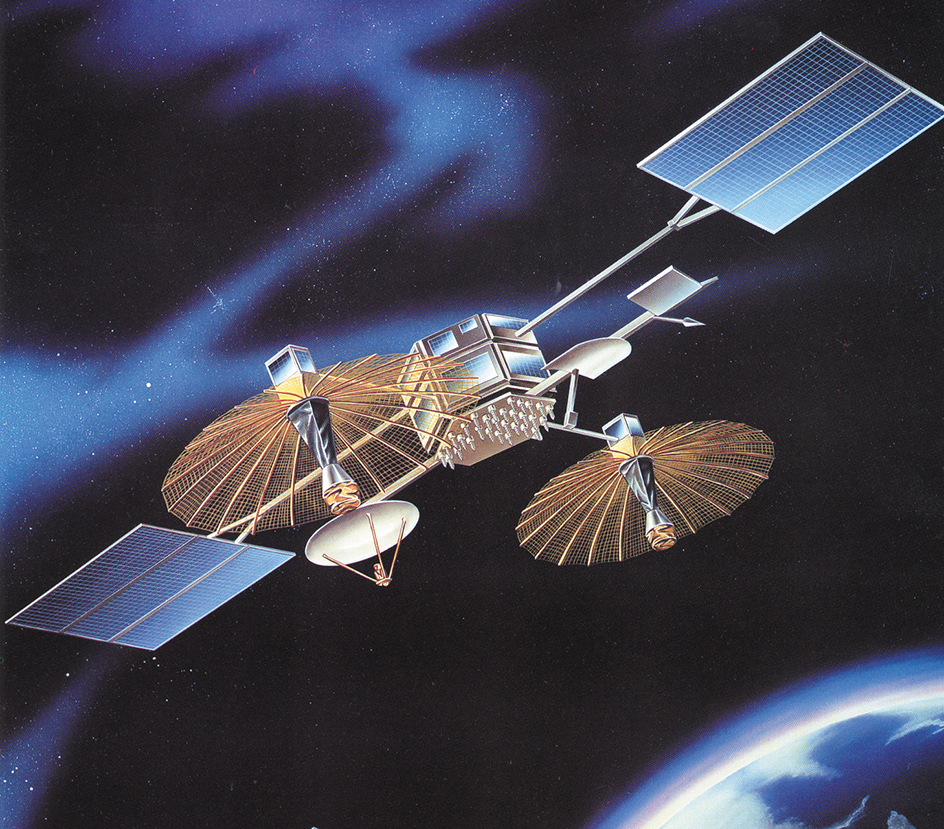Communications satellite is an artificial satellite that receives radio, television, and other signals in space and relays them back to earth. Because a satellite is high above the earth, it can direct radio waves to any place within a large region of the earth, even to a remote area. Without satellites, most radio transmissions could not reach far beyond the horizon. A satellite can send a message to many places at once. Satellites also offer instant service when new radio links are needed quickly. Many companies own satellites or pay a fee to use those owned by others.

Early communications satellites were built to carry long distance telephone calls. Satellites still perform this task, providing service in places where telephone cables are hard to install. They are also used to send telephone signals across oceans.
Communications satellites play a major role in modern television broadcasting. Satellites deliver programs to local cable TV companies or directly to homes through direct broadcast satellite (DBS) systems. DBS subscribers use dish-shaped antennas to receive hundreds of TV channels. Many stores and gas stations use satellites to approve credit card sales.
Types of satellites.
There are two main types of communications satellites, based on their orbits: (1) geostationary orbit satellites, called GEOSAT’s; and (2) low earth orbit satellites, called LEOSAT’s. GEOSAT’s circle the earth in geostationary orbit, an orbit that matches the rate of rotation of the earth. A station on earth can communicate with a satellite only while it is overhead. Because a GEOSAT stays over the same point, it remains within range of its station and need not be tracked.
A GEOSAT has a high-altitude orbit about 22,300 miles (35,900 kilometers) above the equator. From that altitude, it can communicate with about one-third of the earth at all times. A network of three or more GEOSAT’s can transmit signals worldwide. Single satellites may serve one country or region.
A LEOSAT flies lower and faster than a GEOSAT. LEOSAT’s may be only 200 to 500 miles (320 to 800 kilometers) above the ground and orbit the earth about every two or three hours. They must be tracked by stations on earth. Some LEOSAT’s have intermediate or medium orbits, in which they travel slowly at high altitudes on one side of the earth and move quickly at low altitudes on the other. This type of orbit makes tracking easier because the satellite can be monitored longer during the high part of its orbit.
LEOSAT’s can be smaller, cheaper, less powerful, and easier to launch than GEOSAT’s because they are closer to the ground. Unlike a GEOSAT, however, a LEOSAT may be in tracking range for only a short time during an orbit. Once a tracking station loses contact, the transmission is interrupted. Some services, such as electronic mail, can operate with interruptions. Other services, such as TV and telephones, cannot. For a LEOSAT system to provide uninterrupted service, it must have numerous satellites, along with a way to hand off the signal from one satellite to the next.
Communications satellites fire small rockets occasionally to stay in the correct orbit. This process is called station keeping. With GEOSAT’s, station keeping overcomes changes in earth’s gravity and the effects of the sun and moon. LEOSAT’s have such low orbits that the drag of the atmosphere slows them down, and station keeping restores their speed. A satellite’s lifetime is limited by the amount of rocket fuel it can carry. Most satellites last 7 to 15 years.
How communications satellites work.
Communications satellites carry many transponders. A transponder is an electronic device that receives signals, amplifies them, and retransmits them. Transponders are powered by solar cells and batteries. The incoming signals are called the uplink, and the outgoing signals are the downlink. These signals use different frequencies so they will not interfere with each other.

Antennas are the largest part of a satellite. Receiving antennas collect uplink signals for the transponders, and transmitting antennas send downlink signals back to earth. Most satellite antennas are dish-shaped.
The uplink and downlink signals may be in any of several frequency bands, ranges of radio frequencies set aside for a specific purpose. Frequency is measured in units called megahertz (millions of cycles per second), abbreviated MHz. Most LEOSAT’s use the VHF (very high frequency) band, with frequencies from 30 to 300 MHz; the UHF (ultrahigh frequency) band, from 300 to 3,000 MHz; or a band called the L-band, with frequencies near 2,000 MHz. Most GEOSAT’s use the C-band, with frequencies from 4,000 to 6,000 MHz, or the Ku-band, with frequencies from 12,000 to 14,000 MHz.
In general, GEOSAT’s that share a frequency band must be kept about 2° apart in their orbit path around the equator to prevent signal interference. Thus, they are assigned to slots, orbital positions about 900 miles (1,450 kilometers) apart. There are only about 180 slots available per band. LEOSAT’s face fewer restrictions in terms of orbital positioning.
The first communications satellites used analog transmission, a method of sending information through continuous changes in the frequency of radio waves. By the 1990’s, digital transmission began replacing analog. Digital transmission sends information represented by a numeric code, usually a string of 1’s and 0’s, the same code used by computers. Digital transmission resists interference better than analog transmission and provides for clearer sound reception. The digital format also enables satellites to carry many more signals. A typical GEOSAT can carry up to 32 analog TV channels or several hundred digital channels.
History.
Arthur C. Clarke, a British science-fiction writer, is credited with inventing communications satellites. In a 1945 article, he described a satellite in geostationary orbit that could serve as a relay station in the sky.

The first communications satellite was Score, a United States satellite launched on Dec. 18, 1958. Score broadcast a taped greeting from President Dwight D. Eisenhower. Echo 1, launched on Aug. 12, 1960, was the first satellite to relay voice messages from one location to another. It reflected radio signals back to Earth. The American Telephone and Telegraph Company (now part of AT&T Inc.) launched Telstar 1, the first private satellite, on July 10, 1962. Score and Telstar were LEOSAT’s. The first GEOSAT was Syncom 2, a communications satellite launched on July 26, 1963. The first commercial GEOSAT, Early Bird, also called Intelsat 1, was launched on April 6, 1965.
Nearly all of the commercial satellites launched after Early Bird were sent into geostationary orbit. However, in the 1990’s, advances in computers, cellular telephones, and digital communications helped to revive commercial interest in LEOSAT systems.
See also Communications Satellite Corporation ; INTELSAT ; Satellite, Artificial ; Videophone .
